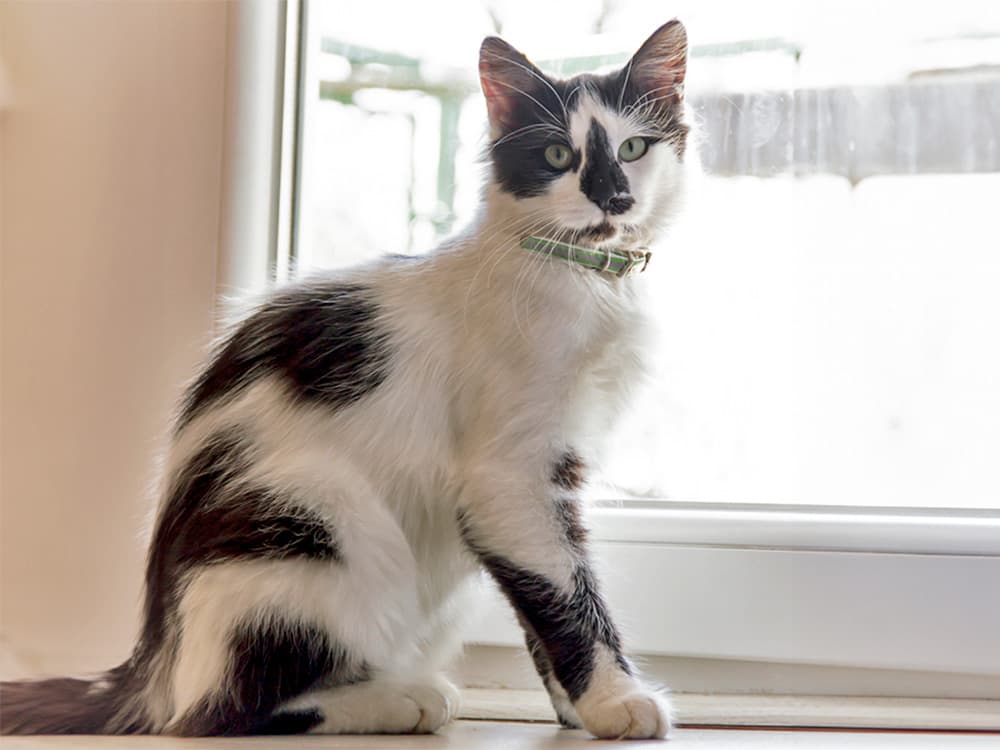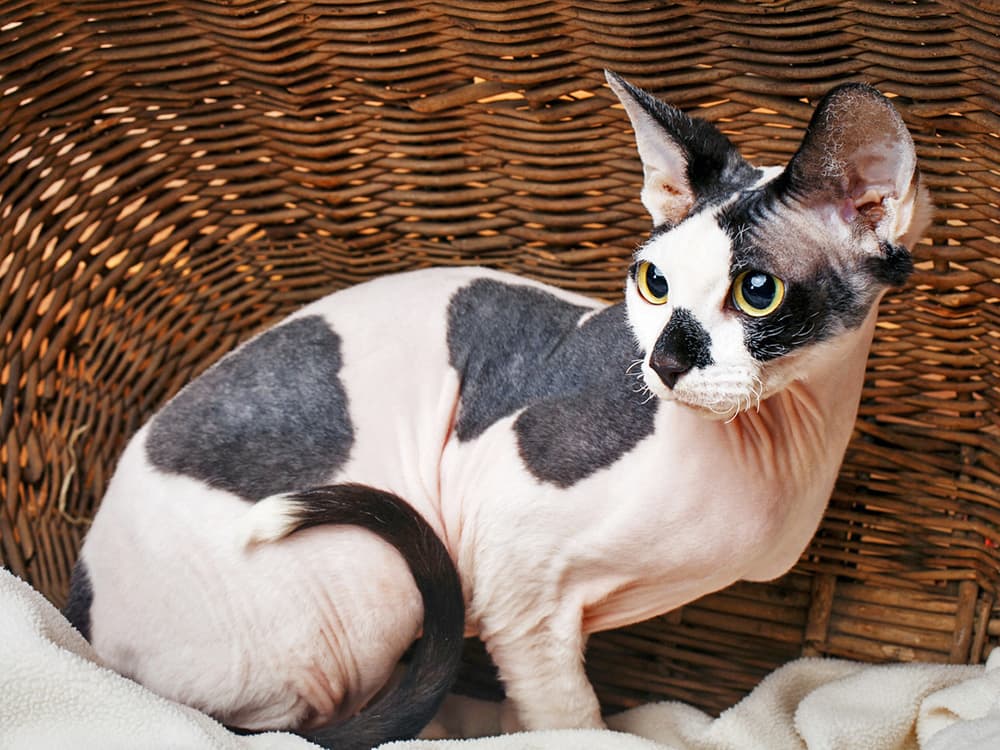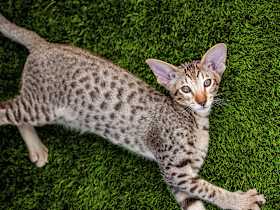8 Beautiful Harlequin Cats Breeds (And Important Facts About Them)
Here’s everything you need to know about the different types of harlequin cats.
Here’s everything you need to know about the different types of harlequin cats.
by Alicia Kort, | May 28, 2024

Meg MacDonald/ Unsplash
If you’ve considered adopting one of these gorgeous cats, we can’t blame you. A harlequin cat refers to a kitty with mostly white fur, plus spots. They can be either bi- or tricolored. This harlequin coloring can also be combined with other patterns, such as tabby or calico, so you could technically have a harlequin calico. Check out these eight feline breeds that sometimes have harlequin coloring, with details of each breed’s personality.
But let’s make one thing clear: These cats aren’t actually a breed type. “Harlequin” just denotes a specific coloring and fur pattern that can be found on any cat. That said, the harlequin cat coloring does show up in certain breeds more than others, such as Japanese Bobtails, Persians, and Turkish Vans. Individual cats’ personality types can vary widely, and these kitties should be judged on their individual personalities when evaluated as potential home companions.
Harlequin cats are named after the comic character in Italian commedia dell’arte, though the harlequin cat doesn’t share a whole lot with their namesake. Harlequin characters usually didn’t speak on stage and wore clothes with a distinctive, colorful diamond pattern. Harlequin cats don’t typically boast that diamond pattern — they’re more likely to have spots or blotches, normally in black but also in red or brown.
Harlequin calico: These kitties are tricolored (white, orange, black), and they typically have at least 40 percent white fur, usually on their bellies.
Harlequin tabby: Tabbies can be striped, blotched, spotted, or ticked. This breed usually has an “M” marking on the top of their heads and other small markings framing their faces. They are usually orange, gray, or white, and can feature the harlequin pattern on top of the tabby.
Harlequin moo cat: Harlequin cats can sometimes be called “moo cats” if they look enough like a spotted cow. Some bicolor harlequin cats are mostly white with huge round spots, which earned them this cute nickname.
Harlequin cap-and-saddle cat: The cap-and-saddle cat is what they sound like — a cat with a dark (usually black) spot on the top of their head and a large spot on their lower back that resembles a saddle. The harlequin cap-and-saddle cat usually appears as a black-and-white kitty.
Harlequin is technically a fur pattern and not a breed, although some breeds tend to produce this fun fur pattern. They might be bi- or tricolored and feature the specific kinds of markings mentioned above.

GmbH & Co. KG / Alamy Stock Photo
If you’re on the hunt for a cuddly harlequin cat, we’ve found the breed for you. The Persian cat is an extremely affectionate, loving companion. They’re mellow and live for attention. Plus, they get along with just about everyone — other kitties, dogs, and older children — though they do thrive best in homes where pet parents are often around to dote on them. This kitty is on the lower energy end of the spectrum, but don’t be fooled, they do still love the occasional playtime. Pet parents who want to adopt Persian cats should be prepared to commit to daily brushing and regular baths or pay for regular grooming sessions.
Weight: 8 to 12 pounds
Lifespan: 15 to 20 years
Best characteristic: Lap cat
Browse for Persians (and their mixes) for adoption

belmac / iStock
The majestic Norwegian Forest Cat does truly appear as if they wandered from a misty forest into your home. Harlequin Norwegian Forest Cats often have white chests and bellies, with black spots along their backs, and black markings framing their faces and on their ears. This furry kitty can be almost dog-like in their devotion: They love nothing more than being by their pet parents’ sides (though not necessarily snuggling on their laps), and enjoy exploring and playing. They’re independent but kind of like a little shadow, following their pet parents around the home. These kitties do get along with other cats, dogs, and children. The Norwegian Forest Cat’s voluminous coat requires weekly brushing and regular bathing. They have one big shedding season, during the spring, when they get rid of their winter undercoat.
Weight: 9 to 12 pounds
Lifespan: 14 to 16 years
Best characteristic: Very fluffy
Browse for Norwegian Forest Cats (and their mixes) for adoption

DuMarafon / Shutterstock
With their short, yet plush, black-and-white coat and chubby cheeks, the harlequin British Shorthair breed looks much like a teddy bear. This cute kitty generally has a laid-back disposition, but that doesn’t mean that they’re indifferent to their pet parents’ presence. They are affectionate and shouldn’t be left alone for long periods. The British Shorthair is compact and surprisingly muscular, so it should come as no surprise that they love to play with other animals and humans alike. With their short, dense coat, the British Shorthair does shed seasonally and requires weekly brushing to keep their coat healthy.
Weight: 8 to 18 pounds
Lifespan: 14 to 20 years
Best characteristic: Calm
Browse for British Shorthairs (and their mixes) for adoption

SerKucher / iStock
Yes, the Sphynx cat breed, which typically only has a peach fuzz coating of fur on their bodies, can appear in a harlequin pattern — it just shows up on their skin and fuzz instead. The Sphynx is a unique, regal-looking kitty who’s known for being more like a dog than a cat. They are silly, playful, highly affectionate, and love to be around their pet parents at all times. The Sphynx gets along with dogs, other felines, and children if introduced gradually and at a young age. Because this cat only boasts the thinnest of fur coats, they are considered to be anearly hypoallergenic cat breed (no cat is truly hypoallergenic) and make good pets for allergy sufferers. The Sphynx requires regular baths to help control the oil that builds up on their skin.
Weight: 6 to 12 pounds
Lifespan: 14 to 20 years
Best characteristic: Hypoallergenic
Browse for Sphynxs (and their mixes) for adoption

Mark Heath / Shutterstock
When they appear in a harlequin pattern, Turkish Vans are usually mostly white, with a few black markings on their ears and faces. Hailing from Turkey, this cat breed’s past life involved keeping fishing boats pest-free. Did we mention that they also love to swim? Although the latter still holds true, today the Turkish Van prefers to roam homes, following their humans around the house, and playing. If you ever want to amuse a Turkish Van, fill up a sink or a tub and watch them bat the water. This breed is high-energy and stays in their kitten stage for nearly five years, so that is something for prospective pet parents to keep in mind. They aren’t the best fit for elderly pet parents who want a more mellow cat. The Turkish Van’s coat is water-repellent and soft to the touch, but luckily, they just need to be brushed once a week.
Weight: 7 to 18 pounds
Lifespan: 12 to 17 years
Best characteristic: Devoted
Browse for Turkish Vans (and their mixes) for adoption

RakhmadStudio / Shutterstock
The Colorpoint Shorthair is a mix between the American Shorthair breed and the Siamese breed, resulting in a beautiful cat who can appear in almost any fur color imaginable (including harlequin-patterned). This breed usually boasts colorful eyes and an outgoing personality. They have high energy levels, love to chat, and are happiest when spending all of their time with their humans. The Colorpoint Shorthair makes a great companion for pet parents who are ready to play and like a Velcro kitty. Though the Colorpoint Shorthair requires a bit more attention than some of the other cat breeds on this list, their coat does not. It’s short, soft, and low-shedding, which means this cat only requires the occasional brushing.
Weight: 8 to 12 pounds
Lifespan: 12 to 17 years
Best characteristic: Very vocal
Browse for Colorpoint Shorthairs (and their mixes) for adoption

Siwaporn / AdobeStock
Domestic Shorthair cats with harlequin coloring can be found in shelters across the country. These cats make wonderful companions for families and individuals alike. Because these cats are of mixed ancestry, they have a diverse appearance, including the possibility of a harlequin coat pattern, and come in a mix of colors.
Weight: 6 to 16 pounds
Lifespan: 12 to 20 years
Best characteristic: One-of-a-kind
Browse for Domestic Shorthair cats for adoption

CC Public Domain / PxHere
The Japanese Bobtail breed often produces harlequin cats. These kitties are famous for their short, bobbed tails (hence the name) and playful personalities. This ancient cat breed used to protect Japanese silk from destructive rodents, so these cats will likely love any mouse toy you throw at them. Affectionate and cuddly, the Japanese Bobtail likes to be around their pet parents and get along with just about anyone, including other cats, dogs, and young children — if properly introduced. This talkative kitty also is more likely to have a chirpy meow instead of a typical cat meow. There are both short-hair and long-hair varieties of the Bobtail, though both have a silky coat that just requires the occasional brushing.
Weight: 6 to 10 pounds
Lifespan: 15 to 18 years
Best characteristic: Their tail
You can adopt a harlequin cat from your local rescue or shelter. You can also search for cats on Adopt a Pet to find the harlequin kitty you’re looking for. Just keep in mind that you will need to take a close look at photos when searching if you’re adamant about finding a kitty with this pattern.
A calico cat can appear in a harlequin pattern, where they are at least 40 to 50 percent white and feature orange and black markings on the rest of their body and face. But calicos aren’t automatically considered harlequin cats. There might be instances where the calico’s body is less than 40 percent white, or they might have a tortoiseshell pattern.
Holland, Dr Mollyann. “Cat Coat Colors.” Hvrh04, 5 Apr. 2018, www.hollandsveterinaryreferralhospital.com/single-post/2018/04/05/cat-coat-colors. Accessed 4 Mar. 2025.

Alicia Kort is a writer and editor living in Brooklyn. She’s currently the senior commerce editor at Apartment Therapy. She’s been published in StyleCaster, Electric Literature, Newsweek, Interview, Brooklyn magazine and more. In her free time, she runs, reads, and spends time with her dog-nieces, Maya and Lady, and her cat-niece, Pepper.

Breed Info

Breed Info

Breed Info


Breed Info
When your lap-cat weighs 20 pounds and still insists on being held, what you should know about large cat breeds.

Breed Info
From silky coats to cloud-like fur, meet the fluffiest kitties around.

Breed Info
Want to adopt a unique cat? Here are a few hairless cats to consider, along with their differences.

Breed Info
They may look like tiny leopards, but these spotted breeds are all about home life.

Breed Info
Here’s a quick guide to finding the right gray or silver cat for you.

Breed Info
These devoted cats are basically love wrapped in fur.

Breed Info
With over 95 percent of cats in this group, it isn’t even a competition.

Adoption Advice
Here’s a primer on the cultural history of black cats, why they look the way they do, and how to celebrate Black Cat Awareness Month.